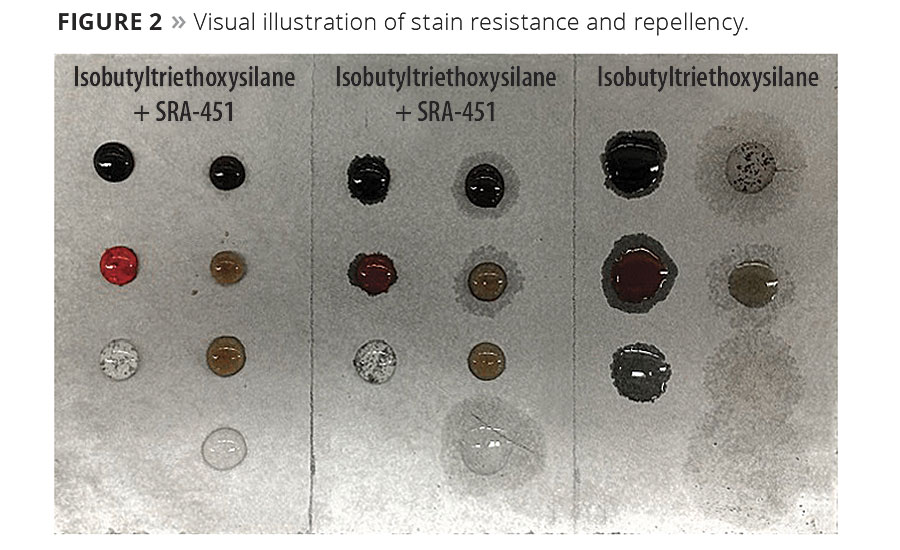Evaluating Fluoropolymer-Based Stain-Resistant Additives and Sealers




















There is growing recognition that improving a product’s resistance to staining and soiling can greatly enhance its appeal, both to consumers and to commercial users. This applies to a wide variety of hard surfaces including porous stone, concrete and tile, as well as construction materials such as paints, caulks and grout. Whether the application is a backyard patio or a bustling auto repair garage, end users require effective, durable treatments that will stand up to long-term use, repeated cleaning and, in many cases, exposure to the elements.
With such a diverse range of applications there is no “one-size-fits-all” solution for achieving desired levels of stain protection. Formulators need to consider which type of base material, concentration, and solvent or solvent mixture would be most suitable for their required application. And in many cases they must balance these considerations with environmental and regulatory concerns that could affect long-term supply.
Fluoropolymer-based additives and sealers represent a relatively novel and evolving approach to stain protection that attempts to satisfy these requirements for a wide variety of surfaces and materials. This article considers a range of stain-resistant additives and sealers based on short chain C4, or perfluorobutane sulfonate (PFBS), technology. These products aim to offer long-term protection from water- and oil-based stains, with less environmental impact and less change to surface appearance and texture than some alternative treatments, including some silicone-based treatments.
A series of controlled tests indicated that these products provide significant levels of stain protection with good durability and weathering, and that the level of protection can be further improved by optimizing the chemical concentration and solvent or solvent mixture for a given application.
Chemistry and Applications
In the first set of tests, a range of PFBS-based additives manufactured by 3M were diluted using a solvent or water to form a penetrating sealer for porous surfaces. In subsequent tests, these products were used as additives to enhance the performance of existing commercial resin-based coating systems. Finally, various formulations were tested for durability and outdoor weathering.
All five products tested (indicated by their commercial designations SRC-220 and SRA-250, 270, 450 and 451) are polymeric materials based on perfluorobutane sulfamido, alcohol and acrylate, with physical compositions ranging from polyurethane dispersion to acrylic emulsion to solvent-based acrylate solutions (Table 1).
Formulation Recommendations
Water-based sealers can be formulated simply by diluting SRC-220, SRA-250 or SRA-270 with DI water to a concentration 2-4% active solid. A small amount of coalescence solvent such as dipropylene glycol monoalkyl ether can help improve stain resistance by increasing sealer penetration. Optionally, a water-based silane or siloxane can be used in combination with these products.
For solvent-based sealer formulations, SRA-450 is designed to be diluted with polar solvents such as esters, ketones, alcohols and ethers, while SRA-451 is designed to be used with nonpolar solvents such as mineral spirits and other hydrocarbons. In both cases, the recommended additive level after dilution is 2-4% active solid.
Penetrating Sealer for Porous Surfaces
In the first set of tests, samples of various tile materials were brushed with a range of formulas containing 3% active sealer and allowed to dry for at least 24 hrs. Coverage ranged from approximately 3.7 sq. meters per liter for concrete and Saltillo to 12.3 sq. meters per liter for marble and granite.
The treated tiles were then tested against a range of water- and oil-based staining agents including red wine, coffee, soy sauce, grape juice, cola, dirty motor oil (DMO), transmission fluid (TF), corn oil and mustard. A 0.10 milliliter drop of each staining agent was applied to the treated tiles, as well as an untreated control sample, and allowed to set for 24 hrs. The tiles were then wiped with a paper towel and cleaned with a sponge and tap water. After drying under ambient conditions, each tile was visually inspected and rated from 0 to 5 based on the following scale: 0 = no visible stain; 1 = trace of visible stain; 2 = outline of stain barely visible; 3 = outline of stain visible; 4 = dark outline of stain; 5 = dark stain had penetrated before cleaning.
The performance of each formula for a given surface was gauged by summing its score for each staining agent, yielding a total stain score. Tables 2-4 show the results for each surface, with a lower total score indicating better stain resistance. Each formula contained a concentration of 3% active solid, and the dilution solvent was water unless otherwise noted.
Several formulations were also tested on granite, providing the visual comparison of the effects of various agents on treated versus untreated surfaces shown in Figure 1.
Stain-Resistant Additive in Resin Systems
A second primary application of these additives is to enhance the performance of existing resin technologies – especially in terms of oil repellency and stain resistance. Certain water-based additives can be used with waterborne resin systems in applications including acrylic concrete sealers and coatings, urethane- and epoxy-based concrete coatings, acrylic- and urethane-based wood coatings, and acrylic-based architecture paint formulations. The recommended additive level is generally 0.2-2.0%.
When used as an additive in such applications, the fluorochemical additive can help enhance water and oil repellency by migrating to the surface and lowering its surface energy. Table 5 compares the water and hexadecane contact angles of several commercial coating systems with and without a water-based fluorochemical additive. It was shown that the contact angles were significantly higher after the addition of the additive, indicating greater repellency.
Similarly, certain solvent-based additives can be used to enhance the performance of solventborne resin systems. In one notable application, the additives can be used to enhance the water and oil repellency of silane formulations. Table 6 shows the significantly improved contact angles obtained by using a solvent-based fluorochemical additive with three common silanes on a concrete surface. It was also found that contact angles can be further improved with the use of nonpolar solvents such as mineral spirits.
A visual illustration of the increased stain resistance and repellency obtained by using these solvent-based additives in conjunction with a hydrocarbon silane formulation can be seen in Figure 2.
Durability
The durability of these stain-resistant additives and sealers was tested by subjecting the treated surfaces to vigorous scrubbing, simulating several washings of a typical flooring material over a period of time. The following procedure was used:
- Apply two coats of each sealer formulation to the limestone tile;
- Air dry for 24 hrs.;
- Measure water and hexadecane contact angles;
- Apply stain drops;
- Allow 24 hrs. for stain to penetrate;
- Wash with water/sponge and allow to dry;
- Rate stain resistance on the previously described 0-5 scale;
- Scrub surface 500 cycles using a Gardner Linear Wear Tester with a Scotch-Brite™ high-performance cloth and 6% aqueous solution of Dawn™ dish washing soap;
- Measure water and hexadecane advancing contact angle again after the tile is dry;
- Re-test staining using same procedure as above.
Table 7 compares the contact angles and stain resistance of the scrubbed and unscrubbed sections of the treated limestone tile. Even after being subjected to rigorous scrubbing, the treated tile showed only slightly diminished stain resistance. Similar testing was conducted using the other additives.
Outdoor Weathering Testing
Among the tested additives, only SRC-220 demonstrated a reaction in UV stabilizer and light stabilizer. Outdoor testing was conducted to measure its resistance to actual weathering. Limestone tiles treated with SRC-220 were exposed for periods of 6, 12, 18 and 24 months in various locations (Miami, FL; Phoenix, AZ; Cottage Grove, MN.) The exposed tiles were then retested and compared to treated tiles that were not exposed to weathering.
The results showed that coating performance was impacted by outdoor weathering to various degrees depending on the period of time and angle of exposure, with the least performance loss found at 90 degrees (vertical). However, in most cases good performance was still observed. In general, one year of good performance was retained on horizontal surfaces and two years on vertical surfaces.
However, these weathering results should only be used as a reference. Real-world performance can vary depending on coating thickness and formulation – including the presence of resins and concentration of active solids – as well as climate and level of exposure.
Summary
Fluoropolymer-based stain-resistant additives offer broad applicability depending on their specific chemistry and formulation. In two major applications – as a penetrating sealer for porous surfaces and as an additive for resin systems and silanes – these products demonstrated significant improvements to stain resistance and water and oil repellency, with generally good retention of performance through repeated cleaning and extended weathering. As such, they can be considered as a stain-protection solution for a wide range of surfaces and environments.
3M and Scotch-Brite are trademarks of 3M Company and all other trademarks are property of their respective owners.
For more information, visit www.3m.com.
Looking for a reprint of this article?
From high-res PDFs to custom plaques, order your copy today!

















